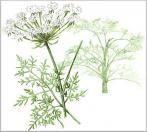Milk Parsley - Peucedanum palustre
Milk Parsley belongs to the Carrot Family (Umbelliferae), one of the richest as far as the number of temperate species is concerned.
This is the same family to which many well-known food and aromatic plants, used since ancient times, belong (parsley, celery, fennel, carrot, aniseed) but also extremely poisonous species like hemlock .
It can grow up to 1,5 m tall and has a large, branched, twisted root and a deeply grooved, erect stem, hollow inside. The basal leaves, up to 50 cm long, are pinnate and deeply divided as far as the median vein.
The umbrella-like inflorescence reaches 3-5 cm in diameter and consists of 10-15 spokes with many bracts at the base, this last characteristic distinguishes it from other, very similar species. It lives in wet meadows, in flooded clearings of hygrophilous Alder woods and on the banks of ditches.
Land reclamation and draining works have almost entirely destroyed its natural habitats in the Alpine Valleys and the Po Valley, where it was once common.
In the Peninsular, it only occurs in the wetlands of north-western Tuscany, like Tanali and Lake Sibolla, which are therefore the southern limit of its distribution in Italy. Peucedanum palustre has therefore become a rare and protected species but there is still a fairly important and vital population on the Sphagnum bog at the margins of Lake Sibolla, where it can easily be seen on the Sedge mounds which offer it a particularly suitable habitat.




